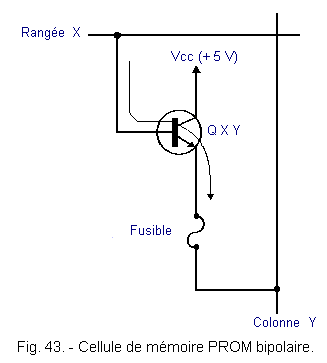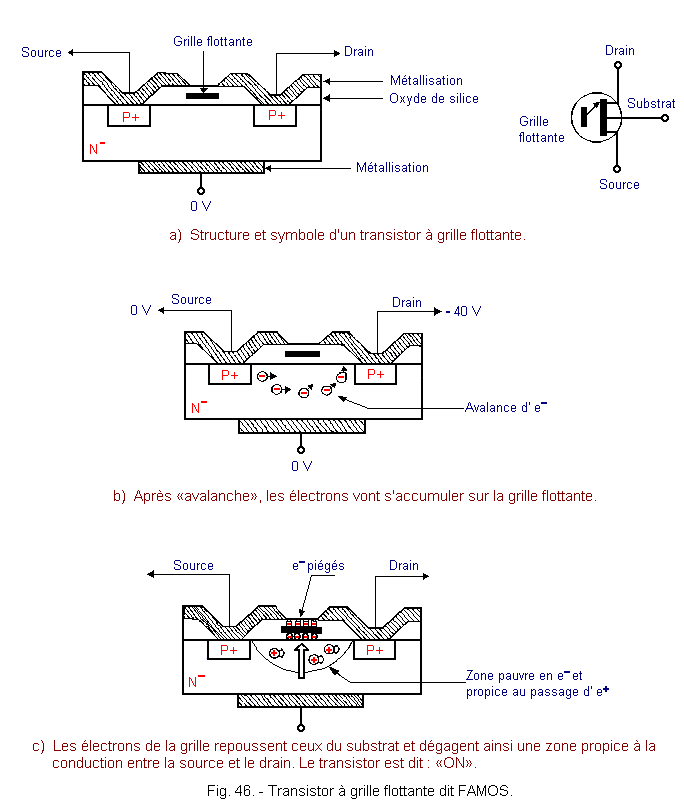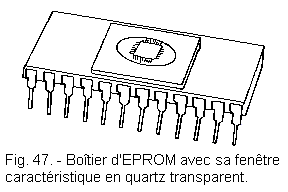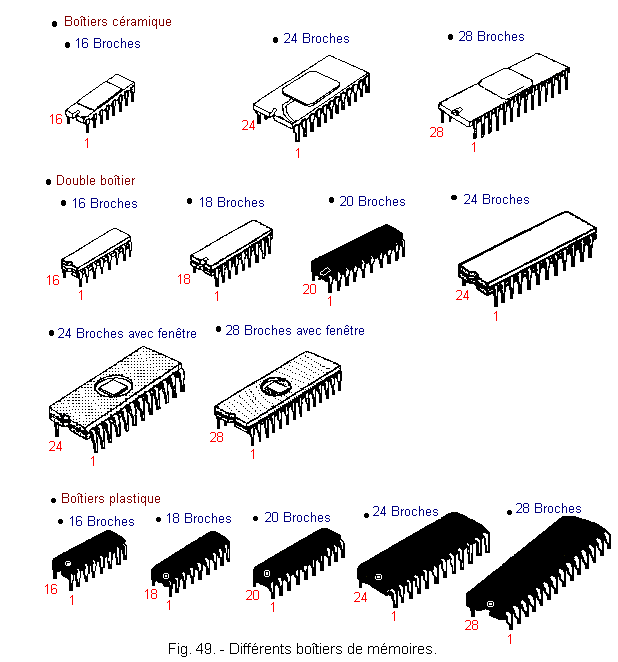 The NOVRAM Memories The NOVRAM Memories |
 Footer Footer |
Programmable ROM Memory - Reprogrammable Dead Memory EPROM or REPROM :
3. 3. - ROM PROGRAMMABLE MEMORY
As we saw in the previous chapter, ROM can not be used outside large series, given the manufacturing requirements.
Therefore, in order to overcome this disadvantage, the manufacturers have developed programmable ROM by the user himself and therefore not requiring special orders, so also no delivery time.
Several different types are available.
3. 3. 1. - PROM (PROGRAMMABLE READ ONLY MEMORY)
These have, instead of the usual electrical connections, fuses that can be melted by means of a PROM programmer.
These fuses can be made of nickel-chromium, poly-crystalline silicon, or tungsten titanium.
Figure 43 shows the scheme of a bipolar PROM cell with its fuse.

In the PROM, the unidirectional diode or transistor element is connected in series with the fuse.
When the fuse is intact, everything happens as in the previous case and columns and rows are connected.
When you want to remove a fuse, just melt it (we say we burn it). This operation is carried out by sending a current pulse which is obtained by temporarily increasing the supply voltage.
Figure 44 shows a fuse which is none other than a narrowing in the driver, so a point of weakness.

Figure 45 shows a fused tungsten titanium fuse during the write and program operation.

A ROM can, thanks to a programmer, be programmed in a few minutes.
Most of the PROM are directly compatible with ROM from the point of view of pinpointing. This is why it is convenient, in the development of a prototype, to use a PROM which will be replaced in the final version by the equivalent ROM.
It is not necessary to program the entire PROM at one time. Generally, one program is part of it at a time as and when needed. Each time new programs are introduced, the remaining part of the PROM can be used.
We can also correct some errors and melt a fuse forgotten, but we can not of course act in the other direction. Because a fusible fuse is irremediably !
A PROM is only programmable once.
3. 3. 2. - MEMORIES DEATH REPROGRAMMABLE EPROM OR REPROM
Once programmed, a ROM or PROM can not be programmed again.
That's why a new kind of ROM has been developed, Electrically Programmable Read Only Memory (EPROM), also called REPROM (Reprogrammable Read Only Memory).
These new memories can be reprogrammed several times. This advantage allows the systems to evolve by making improvements in the programs. Indeed, no program is perfect from the beginning and often it will run a program under real conditions of use to detect certain defects.
To make REPROM, there are several possibilities. We will describe here only the most widespread.
All the unidirectional elements defining the memory points are constituted by special MOS transistors called isolated grid or FAMOS (Flotting gate Avalanche MOS injection) of which one is schematically Figure 46.

a) Programming
Initially, the transistor does not conduct and columns and rows are isolated.
On the other hand, if the control electrode is polarized at the same time as a strong pulse of voltage is sent between the drain and the source, the NP function of the drain starts in avalanche, that is to say that the charge carriers multiply and acquire enough energy to cross the insulating oxide and get trapped by the floating gate.
From this moment and even after disappearance of the programming voltage pulse, these charges remain trapped and the floating electrode remains permanently charged, which makes the MOS conductive.
The phenomenon remains stable for ten years, the loss of load then reaching 30%. But for safety, it is advisable to refresh these memories every five years.
Columns and rows are therefore permanently short-circuited. We see in this case, that we have established a contact (and not deleted a contact as before).
b) Erasure
To erase a REPROM memory, the crystal is exposed for about ten to thirty minutes to «bombardment» of ultraviolet rays.
In order to carry out this operation, the REPROM memory boxes are provided with a quartz window. This protects them from solar radiation rich in infrared, which can thus cause an accidental erasure, but lets pass the artificial ultraviolet radiation used during erasure.
Figure 47 shows such a housing.

This ultraviolet radiation must have a very short wavelength of 2 537 Å (10-10 m) very accurately, with a very high intensity (six watt-seconds per square centimeter). It is therefore recommended not to expose to this radiation, which can cause severe burns to the eyes. This radiation also produces ozone.
When «bombarding» with ultraviolet radiation, the control electrode is biased so as to drive out the charges. The previously trapped charges then receive sufficient energy which again allows them to cross the insulating barrier separating them from the substrate.
The table in Figure 48 gives the main characteristics of some common EPROM.
| Designation | Bit name | Organization | Number of pins | Access time (ns) | Dissipated power (mW) | Vcc |
| 2 716 | 16 384 | 2 048 x 8 | 24 | 450 | 525 | 5V ± 5% |
| 2 732 | 32 768 | 4 096 x 8 | 24 | 450 | 790 | 5V ± 5% |
| 2 764 | 65 536 | 8 192 x 8 | 28 | 250 | 790 | 5V ± 5% |
c) Disadvantages and advantages of REPROM
However, REPROM have two disadvantages.
![]() First of all, it is not possible to modify or delete a single memory position because only a general erasure is possible.
First of all, it is not possible to modify or delete a single memory position because only a general erasure is possible.
![]() Disassembly of the component is necessary for erasure.
Disassembly of the component is necessary for erasure.
Thus, a new category of memories has been created : Electrically Alterable PROM (EAROM), also called electrically erasable PROM (EEPROM), which are electrically erasable PROM.
Erasing and byte byte writing is possible in these memories. For this purpose a pulse of about twenty volts is used.
d) Different technologies used for the manufacture of RAM and ROM.
Figure 49 shows the different housings used for memory packaging.

Figure 50 shows the different technologies used for making memories.

![]() 3. 4. - NOVRAM MEMORIES
3. 4. - NOVRAM MEMORIES
EEPROM also called E2PROM have the advantage of permanently keeping their content (no volatile memories). The number of erasures and writes is however limited. Their erase time is relatively long (10 ms).
This is why it recently appeared on the market of hybrid circuits called NOVRAM, which consist of the association in the same case of a static RAM and an E2PROM.
When the system is powered, only the RAM works, and then we benefit from short RAM access time.
When a power failure occurs, the contents of the RAM are saved in the EEPROM. This backup requires only a few tens of milliseconds, we put large capacitors in the power supply so that they provide the energy necessary for this backup.
On power-up, the RAM is rewritten with the contents of the EEPROM.
 Click here for the next lesson or in the summary provided for this purpose. Click here for the next lesson or in the summary provided for this purpose. |
|
 Previous Page Previous Page |
 Next Page Next Page |
Nombre de pages vues, à partir de cette date : le 27 Décembre 2019
Envoyez un courrier électronique à Administrateur Web Société pour toute question ou remarque concernant ce site Web.
Version du site : 10. 4. 12 - Site optimisation 1280 x 1024 pixels - Faculté de Nanterre - Dernière modification : 02 Septembre 2016.
Ce site Web a été Créé le, 14 Mars 1999 et ayant Rénové, en Septembre 2016.
